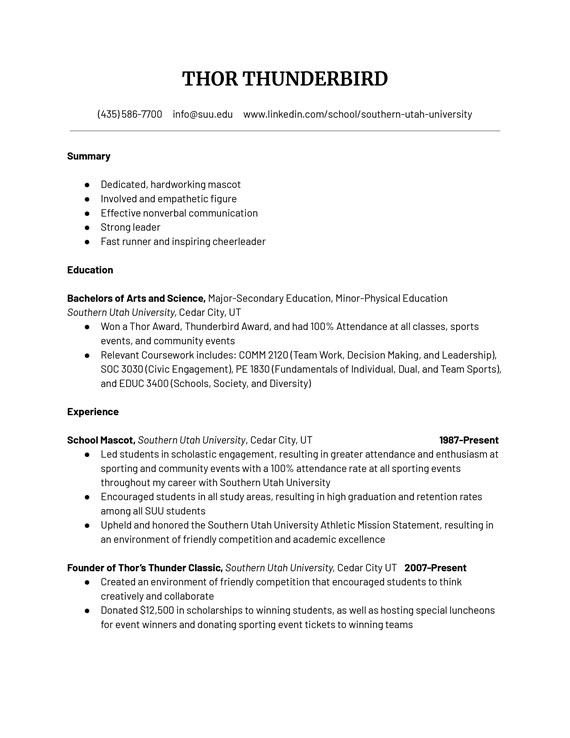How to Write a Resume as a College Student
Posted: April 01, 2021 | Author: Lyndsey Nelson | Read Time: 3 minutes
 Crafting a resume is the first step towards building a career, but in a world of contradicting advice it can be hard to craft the right resume for your job search. With these tips on how to write a resume from the Southern Utah University Career and Professional Development Center, you’ll be able to put together the perfect resume to get you started on your career path.
Crafting a resume is the first step towards building a career, but in a world of contradicting advice it can be hard to craft the right resume for your job search. With these tips on how to write a resume from the Southern Utah University Career and Professional Development Center, you’ll be able to put together the perfect resume to get you started on your career path.
Six Steps to Write a Resume
1. Format Your Resume
The first step to a successful resume is perfect formatting. Your resume should have one-inch margins and be in legible font. At the top of the page, you should include a header with your name, contact information, and an optional link to your LinkedIn profile. This header should be repeated on all pages of your resume and you should maintain the same font throughout the resume.
2. Start with a Summary
Your summary should include relevant information to the employer that demonstrates your qualifications for the job. Begin the first line by giving yourself a title that is relevant to the job, and then follow up with your qualifications and attributes. Be sure not to over or under represent your skills in this section.
3. Include Your Education
In the education section, list your degree obtained first, followed by the name of your place of study and the location. Then, list any special honors or awards or any coursework that is relevant to the position.
4. Add Your Experience
Experience is key! In this section you’ll share your relevant job experience or volunteer work, starting with the most recent position and working backwards in time. Here you’ll want to target your experience to the “Responsibilities and Qualifications” section of the job description. Don’t forget to use the PARQ rule when describing your past experience; start with a Power verb, describe the Action, list the Results, and Quantify your experience with numbers.
5. List References
Your list of references should be included on a separate page and should include former employers or coworkers. Unless otherwise specified by the employer, list three references and be sure to include as much contact information as you have access to. Be sure to specify the person’s position in relation to your own at the company and always ask to use someone as a reference.
6. Other Information
Depending on the job, it may be useful to include a section for other information, including special training, memberships, languages, extracurricular activities, or whatever else you can use to impress your future employer! Be thoughtful when including other information, as it may not always be relevant and may be taking up useful space on your resume.
For a better look at what a resume should look like, check out the example resume on the right.
Putting together your resume can be a daunting challenge, but with these resume writing tips, you’ll be ready to face any job opportunity with your best foot forward. If you have any complications or need extra help preparing for a job, contact the Career and Professional Development Center at SUU and set up an appointment with one of our qualified career counselors.
This article was published more than 3 years ago and might contain outdated information or broken links. As a result, its accuracy cannot be guaranteed.
Tags: Career Center


